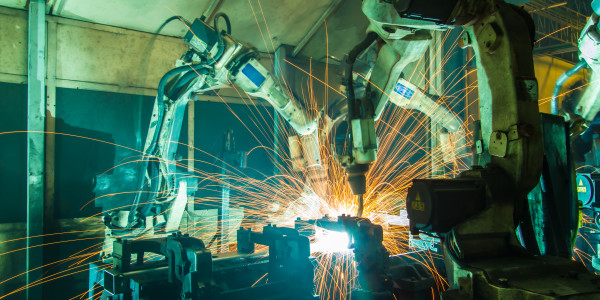It’s a dark and dismal time for manufacturing workers who keep up with their daily news. They sit down at the breakfast table with a cup of coffee and their morning paper – or more likely an aggregated newsfeed – before heading in to the factory for their shift. Between political turmoil and their favorite sports team being upset by the underdog, there’s nothing but negative and stressful news regarding the future of employment in manufacturing.
Some mornings it’s clear that robots will soak up all of the manufacturing jobs, leaving you unemployed. Other mornings you learn that manufacturing jobs will continue to exist, but you’re not skilled enough to work in manufacturing. Or maybe you’ll still have a job, but a robot will outrank you on the totem pole.
There’s just no winning for blue collar workers.
Unemployment
People often associate automation with decreases in manufacturing jobs. Offshoring led to a plummet in employment in U.S. factories. While there’s been talk of reshoring, the increase in American manufacturing jobs doesn’t reflect the increases in U.S. manufacturing output.
A common explanation is that manufacturing is becoming increasingly automated, and there’s simply not the need for the number of employees that there used to be. It doesn’t matter whether manufacturers bring production back to the states, because machines will do the work rather than humans.
Skills gap
OK, so factory jobs are still available. You just don’t have the knowledge, education, skill, or training to perform them. The other side of the aisle believes that automation doesn’t get rid of human workers, it just displaces the workforce.
This means that automation allows people to focus on more meaningful jobs, including the operation and management of sophisticated industrial machinery. The trouble is that our current workforce is equipped to perform the low skill labor in factories rather than the high skill work.
Collaborative robots
You will still have your job, but robots will work alongside you. Collaborative robots can improve the capabilities of human workers and maximize the efficiency of the manufacturing process. Some robots, such as automated systems and artificially intelligent programs, will work in the back office.
Some workers might take issue with being outranked by a robot.
Focus on the positives
Maybe the negative headlines get more readers, or maybe people really do have a negative outlook for the future of manufacturing jobs.
Automation is great, though. We should focus on the positive aspects of automation rather than fear the negative.
It makes work safer, easier, and more enjoyable for human workers, and it allows us to pursue more worthwhile types of work. While we can’t predict the future, we can look at the past. There’s a long history of fearing automation, but there are still manufacturing jobs today.
It’s true that the U.S. doesn’t have the same level of employment in manufacturing that we’ve had in the past, but we probably won’t reach historic highs again. The world’s changing and automation is going to continue becoming more central to everything we do.
Call 479-422-0390 for support, service, or repair for Indramat motion control systems.
